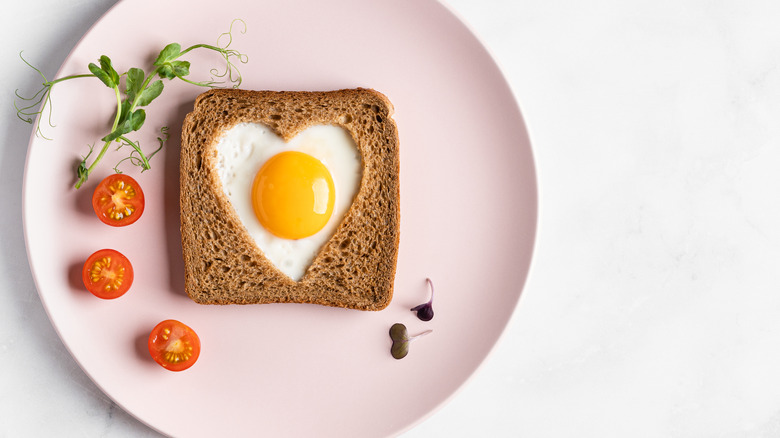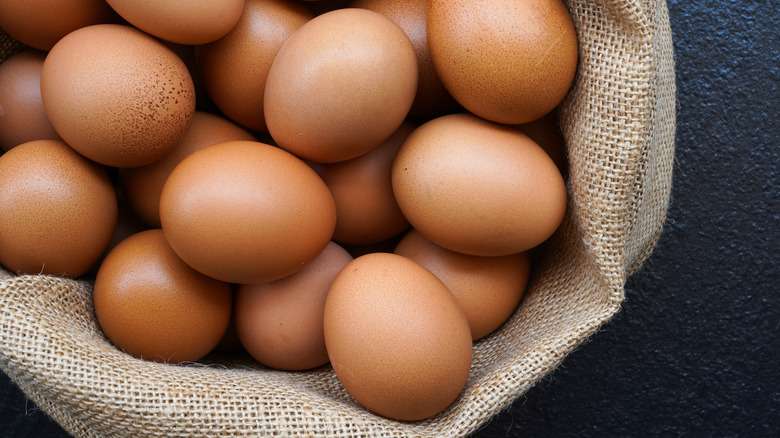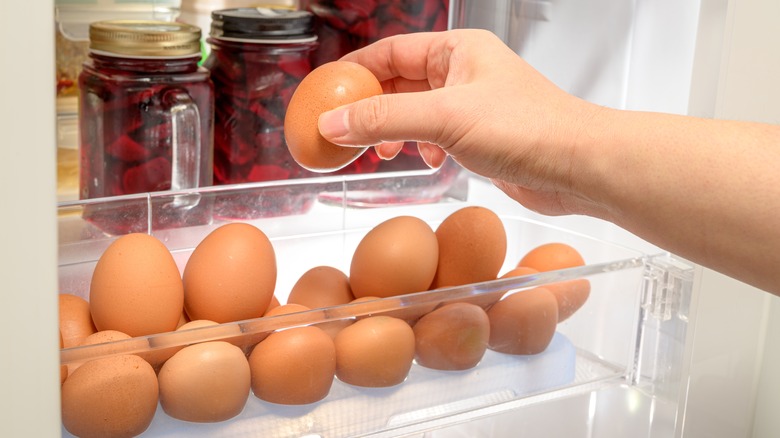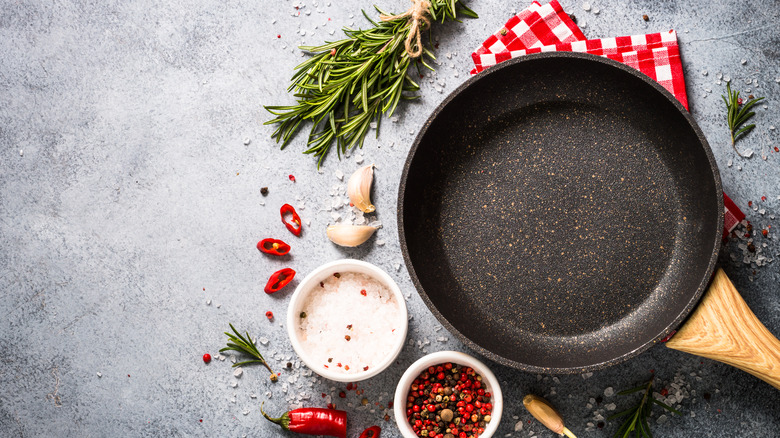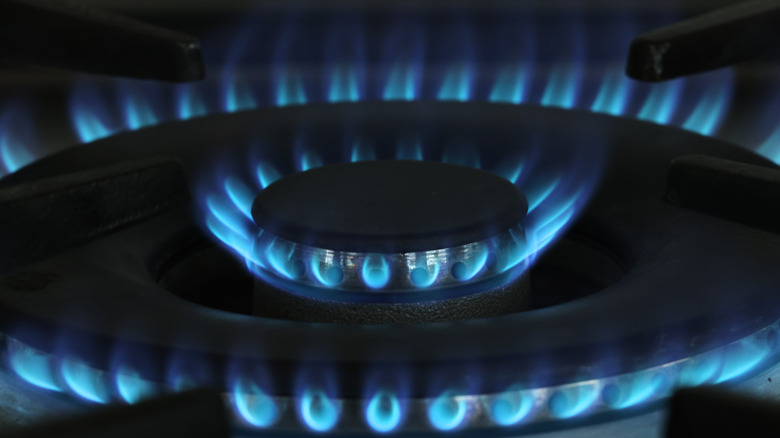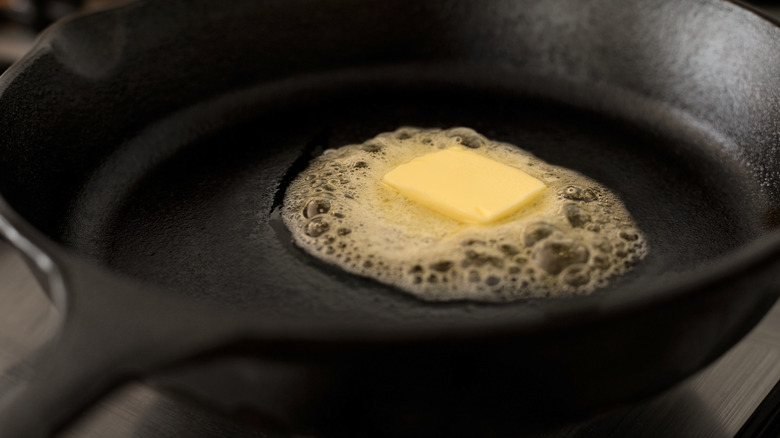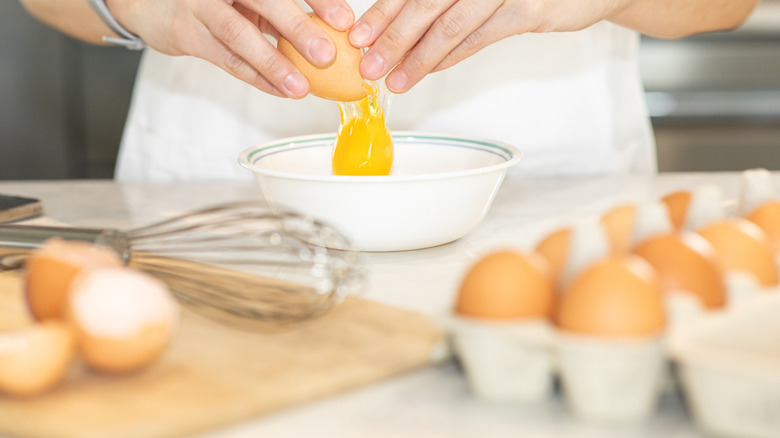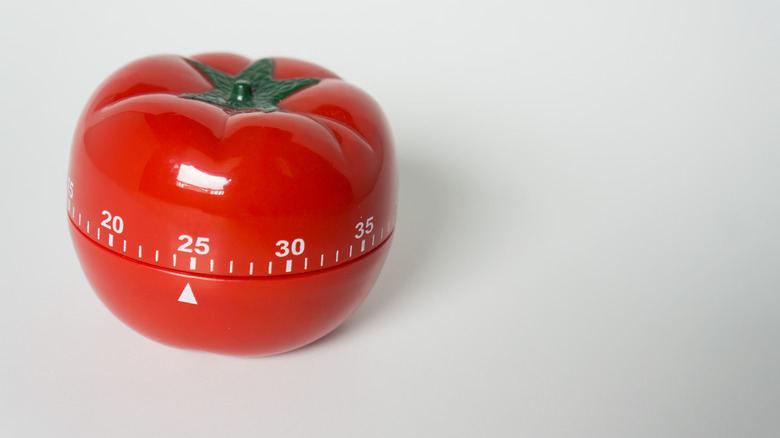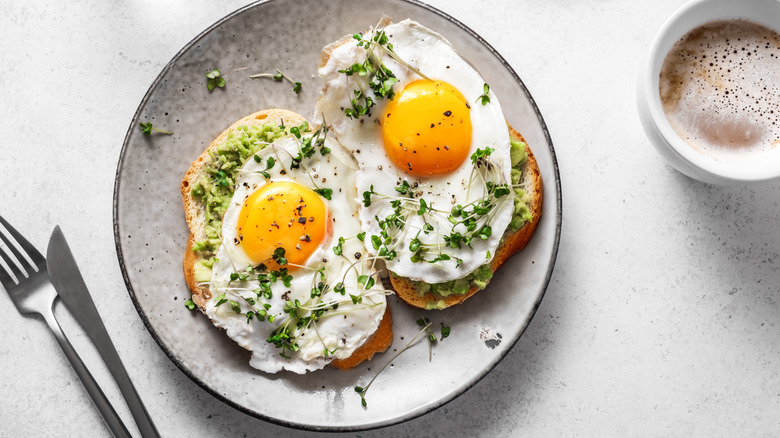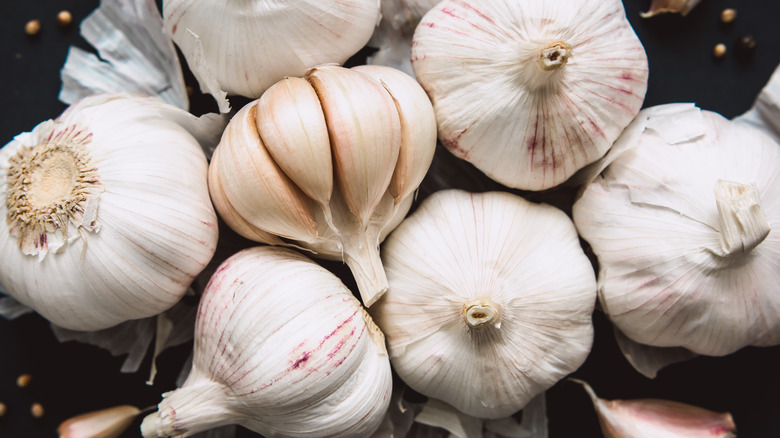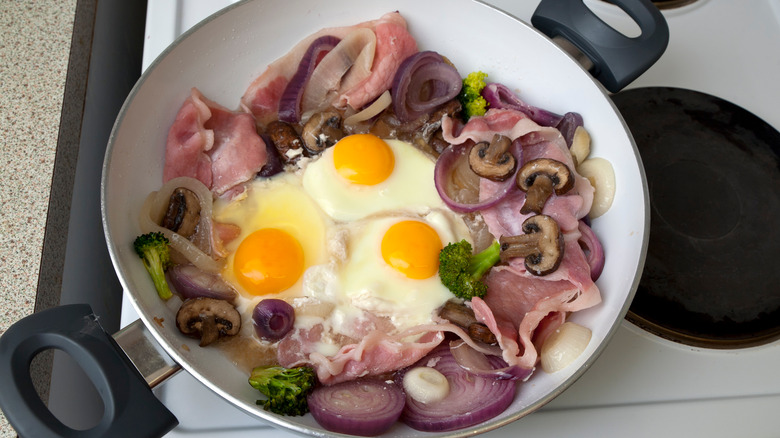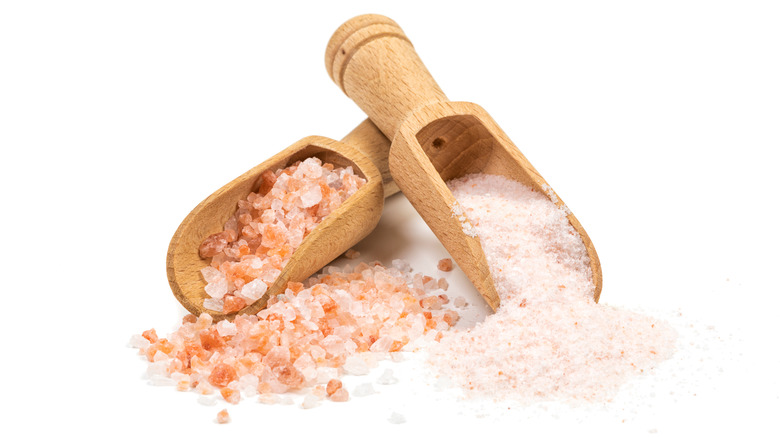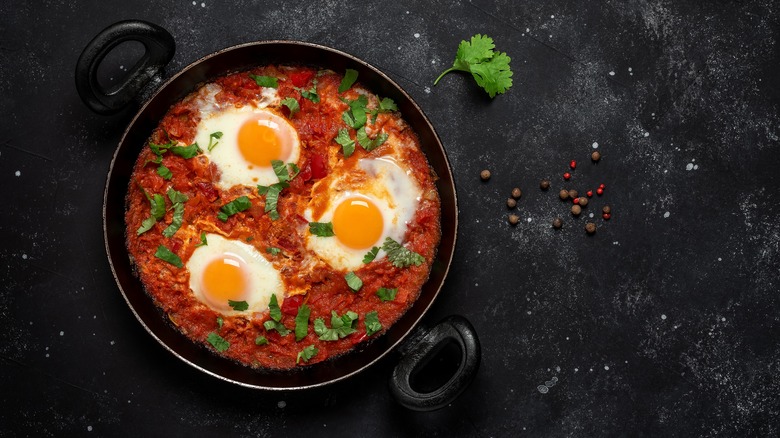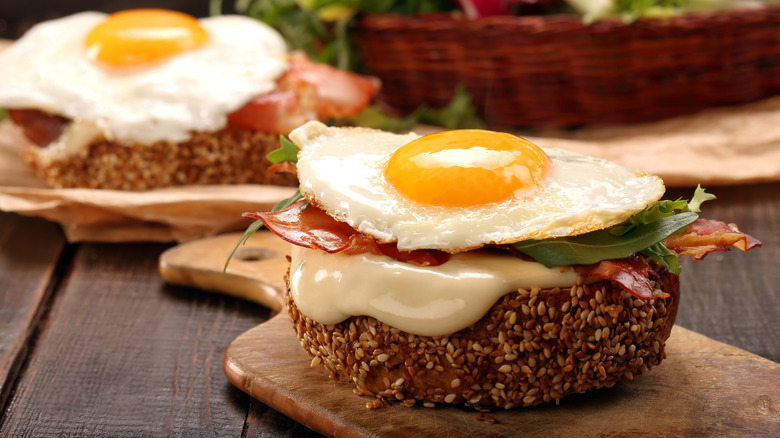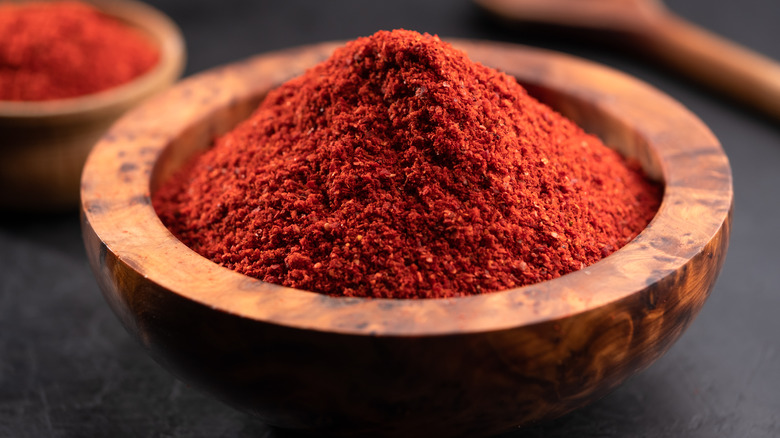13 Ways To Make Your Fried Eggs Even Better
Kids from the '80s remember "the incredible, edible egg" as a popular slogan. Eggs are still incredible, and we're still eating plenty of them. Statista reports that the U.S. is projected to eat about 288 eggs per capita in 2022. That's a lot of eggs, and it's no surprise. Compared to other foods, eggs are still relatively inexpensive, nutritious (hello, protein), and they're quick and easy to cook. Want some more good news? Although eggs have a slight reputation for containing cholesterol, you can eat up to seven eggs a week without worry. Even better, protein-rich eggs are the perfect bedtime snack, thanks to their ability to digest easily.
The egg might be a simple choice for a meal, but it never has to be boring. Fry them, flip them, and let them swim in butter. Using our 13 ways to make your fried egg even better, you'll never look at eggs the same way again.
Choose the right eggs
Before enjoying fried eggs, learn how to choose the right egg for the job. Sometimes you just want to grab the eggs that are on sale, and there's a time and a place for that. However, when you're after the perfect fried egg, it's worth making an effort to pick the right type.
They all kind of look alike except for the color choices of brown and white, so how do you choose? According to Sauder Eggs, you should never settle for store-bought eggs that aren't stamped by the USDA. This ensures the eggs have met strict quality requirements. Of course, choose the size you prefer, which is usually regular, large, or extra-large. You'll notice eggs are given a grade of either AA, A, or B. Grade AA is the highest quality aesthetically, but Grade A is not far behind. Either is a good choice, but they're all safe to eat.
Once you've settled on the right carton, carefully check each egg for cracks. You don't want to bring home a carton of eggs with a few you can't use. Also, take a sniff. The eggs shouldn't smell funny. Finally, what's the expiration date on the carton? Eggs are usually good for a few days after the "sell by" date. If you aren't sure, you can check eggs for freshness at home by seeing if they float or sink in a glass of water.
Don't cook a cold egg
You're hungry and want your eggs right now. We get it. But, if you want the best fried egg, you need to let the eggs warm up a bit.
So, if eggs are better at room temperature, why refrigerate them in the first place? Eggs you buy in the grocery store that are certified by the USDA have been cleaned before they are put into cartons (we appreciate that). The cleaning removes a film from the eggs that protects them from bacteria. Eggs sold in the U.S. require refrigeration because that film is gone, and the coldness of the refrigerator will slow down the multiplication of bacteria. Farm fresh eggs, however, can sit on the counter for a day or two without refrigeration as long as they aren't washed.
So, best to keep your store-bought eggs refrigerated, and bring them to room temperature before letting them hit the frying pan. Room temperature eggs cook more evenly, and you won't end up with ends that are overdone and a middle that's unappetizingly slimy.
Use the proper frying pan
There's a constant debate over which pots and pans are the best. Do you prefer nonstick? Cast iron? Stainless steel? And does it even matter? Yes, yes it does. One of the mistakes people make when frying eggs is not using a nonstick pan. Isn't it frustrating when you're happily frying an egg, then you go to flip it over or slide it out of the pan and it doesn't want to budge? No matter how much grease you use, nothing compares to nonstick when it comes to the perfect fried egg.
Nonstick has at times, gotten a bad rap. There's concern over its safety when it comes to our health. Thankfully, Scientific American explains that nonstick pans are perfectly safe, especially when you spend a little more on them. When the coating flakes, it's ingested, and the cheaper pans tend to flake easier. So, if you want nonstick, invest in high-quality.
If you don't have a nonstick pan on hand, there's no need to panic. Take out your trusty cast iron skillet. Here's the thing – eggs love to stick to cast iron; however, you can prevent your eggs from sticking as long as you pre-heat the cast iron pan and use plenty of butter or oil. The same can be said for stainless steel.
Turn up the heat when you fry eggs
Some like it hot and so do your eggs – just not too hot. Sizzle your eggs, but don't accidently burn them. Tempting as it may be when your stomach is telling you to hurry up, an intense flame under the skillet is not your egg's best friend.
One of the biggest reasons to not fry an egg over high heat is because the whites will turn out rubbery and tough. Also, the yolk can become overdone quickly, and you'll end up with a crumbly, yellow, dried-out mess on your plate. Gross. Instead, aim for low and slow when frying eggs. Set the flame at low to medium, then keep an eye on your eggs as they fry. Let them cook for several minutes to get the crispy edges you like or just a minute or so for the perfect white, sunny-side-up egg you prefer.
Should you cook eggs with butter or oil?
Finally, your eggs are at room temperature, you've chosen a pan, and it's time to cook. Even if a pan is nonstick, you'll need something greasy to make sure nothing gets left behind. Your two options are butter or oil.
We all know butter tastes fabulous. Can you even trust someone who doesn't like butter? No, seriously, butter is great and works perfectly when frying an egg, as long as you use plenty of it. If you love the salty flavor, butter is a great choice for cooking eggs. Still, butter has a high concentration of saturated fat, so if you're trying to avoid that sort of thing, you need other options.
Say hello to olive oil. Frying eggs in olive oil is the perfect alternative to butter. You get great flavor, a slippery pan, and you can add as much olive oil as you need since it has health benefits. Another oil full of flavor and good for you is coconut oil. Coconut oil has a high smoke point, so it's excellent when frying. Choose unrefined coconut oil when pan frying eggs.
Crack the eggs properly
Yes, there's an art to cracking an egg. Mastering it will give you less mess and less chance of breaking the yolk. A mistake people often make when frying an egg is cracking it on the lip of the pan. Seems convenient enough; however, you risk making a mess and getting some shells in your eggs. Instead, crack your egg on a hard surface, then gently insert your thumbs to open it. On a side note, if you do accidentally break an egg incorrectly, you can remove eggshells from your eggs by wetting your fingers and sliding out the pieces or use a big half of the eggshell to scoop them away.
Once your egg is cracked, don't just plop it in a pan. Crack your egg into a bowl instead. From there, you can gently slide the egg into your prepared skillet. This way, there's less risk of the egg splattering and the yolk breaking.
How long should you fry an egg?
The times vary for cooking an egg depending on if you're a fan of runny or solid yolks. Egg connoisseurs are a bit like steak enthusiasts who argue over rare versus well-done. Even those who prefer a runny yolk, take their personal stance on over easy or sunny side up. Both are similar and really the only difference between sunny-side up and over easy is the fact that you flip a sunny-side egg to make it over easy. Either way, when eating runny eggs, some people question how safe it is since there is a risk of salmonella with undercooked foods. According to the CDC, there's no need to give up your runny fried eggs as long as you choose pasteurized eggs and keep them refrigerated.
Now, let's talk about time. For a sunny-side up egg, cook it for about one to two minutes, basting it with fat as it cooks (via MasterClass). For your over-easy eggs, cook about one minute, then flip and cook the other side about 30 seconds. For an over-medium egg, which will have a soft but not runny yolk, cook for one minute after flipping. Add an additional minute for an over-hard or well-done egg.
Make eggs green with herbs
As marvelous as the egg is, it lacks in flavor without a little help. It's nothing some fresh herbs can't fix. Unfortunately, you may not always have fresh herbs on hand, and the ones you bought last week are now wilted and unappetizing. Prepare ahead of time by storing fresh herbs in the refrigerator, so you'll have the herbs you need, the next time you fry some eggs.
Tender herbs, such as parsley, cilantro, or basil can be placed in the refrigerator in about one inch of water, after trimming off the bottoms, and covered with a plastic bag to slow the decaying process. Woody herbs, like rosemary or sage last longer when wrapped in a damp paper towel and sealed in plastic in the refrigerator. When frying eggs, chop herbs finely and sprinkle on top while the egg cooks to infuse the flavor, or add the chopped herbs after for an even fresher taste. You could also put a whole herb, such as a sprig of rosemary, alongside the egg as it cooks for a milder herbaceous taste.
Add garlic for additional health benefits
Garlic is like butter – it simply makes everything better. And unlike butter, there's no need to hold back with garlic. WebMd explains that garlic is known for fighting off fungi, bacteria, and viruses. It's time to adventure out beyond garlic bread and spaghetti sauce. Your eggs are another way to get some aromatic, spicy, sweet, garlic into your life.
Slice it, dice it, chop it, or crush it, then before the egg enters the pan, sauté your garlic for a bit in the heated butter or oil. When cooking with garlic, allow the fresh garlic to rest for about 10 minutes after you've chopped it up and before you cook it. With garlic's many health benefits, the resting period brings out the enzyme in garlic that turns into allicin, which is the potent compound that gives garlic its healthy reputation.
After the garlic sautés until it's soft, you can then place the egg right over the garlic slices to allow the egg to fry and absorb that sweet flavor. As you baste with fat while the egg fries, you'll get even more garlicky flavor.
Use bacon to improve your eggs
Bacon and eggs were made for each other, so why not mix them together? To make mixing quicker, keep some cooked bacon on hand so you can crumble it on top of your fried eggs. To do this, Coleman Natural Foods recommends allowing the bacon to cool to room temperature, then place the strips in a tightly sealed plastic bag with the air removed, and store in the refrigerator for up to five days. You can use the same method with a freezer bag and freeze bacon for up to one month.
Of course, if you have the time, nothing beats freshly cooked bacon. For crispy bacon, and to leave more room on the stovetop, try baking your bacon instead of frying it. You can make a larger amount at once in the oven, and there's way less mess to clean up from splattering bacon grease.
If you prefer whole slices of bacon, rather than crumbles, lay the cooked bacon right on top of the egg as it fries or place strips next to the egg in the skillet. This method adds a lot of flavor to the egg, gives it extra grease to cook in, and brings new meaning to the phrase, "bacon and eggs." For serious bacon fans, fry the bacon first in the same skillet you'll fry the eggs. Use the bacon grease for the eggs to cook in, rather than butter or oil.
So many salts, so little time
Salt brings out the flavors in food and can turn a bland dish into a mouth-watering explosion. An egg might not be considered decadent on its own, but with the right salt, it's well on its way.
Regular table salt will do just fine in a pinch, but how about some sea salt for something different? One of the differences between sea salt and table salt is the flavor. Sea salt has naturally occurring minerals that table salts don't have, which lends to its subtle flavor and makes sea salt the perfect finishing touch to your fried eggs.
Another unique salt for your fried eggs is Himalayan pink salt. Some people enjoy the taste of this salt more than regular table salt. It's often coarsely ground, giving it more texture, but can also be found finely ground like table salt. Himalayan salt gets its gorgeous pink color from the minerals that are in it. Even if you don't find the taste to be unique, you may enjoy your breakfast more as you finish your eggs with something pink.
Add hot sauce to eggs for a bit of heat
Are you the spicy type? Well, your eggs can be too. Add a little hot sauce for a wake up call in the morning. Simply sprinkle your favorite sauce on your fried eggs after they've cooked and enjoy. Try making your own hot sauce using onion, garlic, cubanelle, habanero, and serrano peppers, red bell pepper, tomato, olive oil, and salt. Cook the veggies in oil, strain, then blend it all up and season with salt to taste. To enjoy your fried eggs with hot sauce and a little extra pizazz, use our fried eggs with Thai long pepper and hot sauce recipe. All you need is your fried eggs, a Thai long peppercorn, sea salt, and your favorite hot sauce. Fry the eggs in clarified butter, season with grated peppercorn and sea salt, then drizzle the eggs with hot sauce to finish.
Love hot sauce but hate the heat? You can make your hot sauce a little less spicy without sacrificing flavor. Simply determine the base of the sauce (for example, tomato sauce or vinegar) and add a little more of that. Or, you can add some sour cream or sugar to reduce the heat.
Turn your fried egg into a sandwich
Sometimes your fried egg needs a partner, and bread is the perfect option. Fried egg sandwiches are great on the go and will keep your tummy full. Try a traditional egg sandwich with your fried egg and cheese or add some meat, such as ham. Don't stop there, though. You can add just about anything with an egg and have a protein-packed meal in your hands.
Love Kimchi? Check out our fried egg sandwich with bacon and kimchi recipe. It contains homemade mayonnaise, crispy bacon, browned rolls, cabbage kimchi, and of course, fried eggs. Another recipe to try is a fried egg sandwich with potato and romesco recipe. You'll cook Yukon potatoes until crispy, fry your eggs, then spread romesco sauce onto toasted focaccia bread and put it all together. Yum.
The results are easy mealtime prep and healthy food on the go.
Use colorful paprika with eggs
You've seen it on deviled eggs, and now it's time to share what paprika has to offer with your fried eggs as well. With its bright orange-red color, paprika adds a little visual appeal and plenty of flavor.
To use paprika to season your eggs, simply add some to the oil they're cooking in. Olive oil mixed with a little paprika will make a beautiful color and a delicious flavor that might help you move away from butter, if that's something you need to do. Savory Spice shares that paprika is made from grinding dried red peppers into a fine powder, as you see in the spice aisle of your grocery store. It ranges in flavor from mild to hot and spicy, and you can even choose smoked paprika for smoky eggs.
Fortunately, eggs are a healthy meal choice. When frying, you can allow your amateur chef to rise to the occasion with creativity and skillful seasoning.
